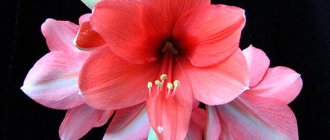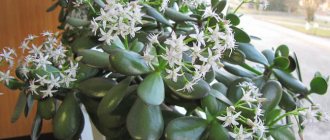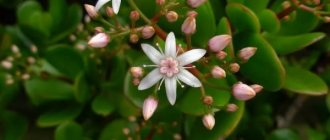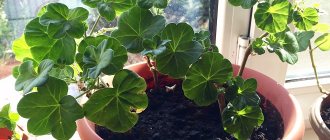Cyclamen is also called alpine violet and dryberry. It has an unpretentious character and pleases with wonderful flowers. The juice of the plant is used in traditional medicine recipes and pharmaceutical preparations, mainly related to the treatment of ENT diseases.
It has soothing, anti-inflammatory and antiseptic properties. It is destructive for most microorganisms, destroys viruses that provoke the development of colds, frontal sinuses, migraines, and inflammation of the maxillary sinuses.
Important : uncontrolled use of cyclamen extract for health purposes is dangerous.
The following varieties are most often found on window sills: Adjarian, European, Persian. There are about 20 species of perennials in the genus. They require an unpretentious attitude, which is why they are especially popular.
Bud formation
Cyclamen begins to bloom after its dormant period ends (from the very beginning of June to September), and this happens gradually. From September to November, the plant “wakes up”: new green leaves begin to appear on it. And in December, when it has returned to the state it was in before hibernation, the plant finally begins to bloom: bright and variegated flowers grow on the peduncle, which do not fall off until the beginning of May.
Under all conditions created for the correct dormant period, cyclamen will bloom regularly.
Are there varieties of spathiphyllum that bloom with green flowers?
In addition to a long spadix, the spathiphyllum plant also has a bract - a “spread”. Brightly colored bedspreads can have different shades. Changing color to green is often a cause of concern even for experienced gardeners. There are several reasons for this
It is important to understand: why do spathiphyllum flowers appear green, what to do?
Spathiphyllum flower
The spathiphyllum plant is represented by a wide variety of varieties. The most common ones found in flower shops are:
- Charming. It is distinguished by the shape of the leaf plate with the most clearly defined veins. The inflorescences are light green. Following the rules of care allows you to achieve year-round flowering.
- Abundantly flowering - the smallest representative of spathiphyllum. Capable of blooming throughout the year.
- Chopin has been the most popular subtype for many years. The plant is able to absorb harmful air and saturate the environment with oxygen. The perianth is white and has a green edge. The flower plate is painted white.
- A rare representative of the species is the Picasso variety, which is one of the brightest spathiphyllums.
Abundantly flowering variety
On a note! In some varieties, greening of flowers occurs “with age.” For example, in the variety Helikonyelistny.
The necessary conditions
First of all, active and regular flowering directly depends on how it spent the dormant period. When caring for cyclamen during the dormant period, you need to follow some simple conditions:
- The temperature should not exceed 20 degrees, and the most optimal would be 12 - 13 degrees. The plant itself should be in a dark place where it will not be exposed to direct sunlight.
- Watering is done once every 2 weeks, but you need to monitor the soil moisture and do not flood it. Otherwise, rotting of the bulb and subsequent death of the flower may occur.
- During this period, it is better not to feed the plant at all; at this stage, feeding will only harm the cyclamen.
After a period of dormancy and awakening of cyclamen, it is necessary to provide the conditions necessary for its flowering:
- There should be no damage to the flower in the form of cracks, otherwise it will begin to rot and die instead of blooming.
- After hibernation, the plant is transplanted into new nutrient soil, and when placing the bulb in the ground, it is necessary that 1/3 of it is above the ground. This is necessary for flowering to begin at all.
- It is best to place cyclamen on a south or west window, because there is no bright direct sunlight, which causes great harm to the leaves of the plant. If it is not possible to keep it on the windowsill, you can place it in any place where there is no direct sunlight.
- Maintaining a comfortable temperature for cyclamen: during the flowering period it should not rise above 15-18 degrees. At this time, he prefers coolness, as at rest.
- It is recommended to increase watering to once a week, and it is important to monitor whether the top layer of the substrate dries out and whether water stagnates at the bottom of the pot where the bulb is located.
You can make holes in the bottom of the pot and put a tray down where excess water will drain. Important! When watering, do not allow moisture to get on the leaves. - Before the cyclamen begins to bloom, i.e. during its awakening, you need to spray its leaves, and best of all, the air around it. Such spraying can be carried out once a week.
- Feeding occurs once every 2 weeks with complex fertilizers that are suitable for absolutely any plant.
This type of care for cyclamen should be done until its leaves begin to turn yellow and fall off along with the flowers, i.e. until the very beginning of the dormant period.
What to do to make cyclamen buds and bloom
Cyclamen - when it blooms, what it looks like
Ignoring the requirements of cyclamen when growing leads to the fact that the plant only grows leaves and does not form flower buds.
The most common errors and solutions:
- The pot size is too large - choose a smaller container.
- High air temperature - choose the coolest place in the house. In emergency cases, the plant is briefly placed in the refrigerator.
- Waterlogged soil - wait until the top layer of soil dries out.
- Overfeeding with fertilizers - reduce the application rate.
- The appearance of pests or diseases - weekly preventive inspection.
Lack of flowering may be caused by non-compliance with dormancy. When the errors are corrected, the plant will bloom again.
Cyclamen has a reputation as a capricious flower. The plant may die if care is taken seriously. But under favorable conditions, cyclamen will delight you with long and abundant flowering all winter.
Causes
The most important and common reason why cyclamen refuses to bloom:
failure to comply with the conditions listed above, perhaps watering was rare but plentiful;- it was not fed and so on.
If he has done everything that was required of the grower, and the plant still does not begin to bloom, you need to take into account whether the cyclamen was purchased in a specialized store or propagated at home.
In the first case, everything is somewhat more complicated: in order for cyclamens to always have a marketable appearance, they are fertilized with chemicals that force them to bloom constantly (or most of the year). As a result of such feeding, the plant’s life cycle is disrupted, and you just need to wait until it returns to normal. It is for the same reason that cyclamen may not hibernate.
On a note. If the plant is young, it may also not bloom, because it also has not yet set up its cycle, according to which it will live in all subsequent years.
In most cases, cyclamens begin to bloom only after 2-3 years of their “life ,” so there is no need to expect that a plant that has just been transplanted into its first individual pot will begin to actively bloom.
It is possible that the cyclamen rhizome rots as a result of improper watering or damage to the bulb during transplantation. In this case, you need to replant the flower again, while ridding it of the damaged parts. Or it has been attacked by pests, which need to be gotten rid of immediately.
Why does cyclamen shed its leaves, how to save the plant from death?
Cyclamen can shed its leaves for several reasons. You can understand whether this is a reason for concern if you carefully observe the flower. If it begins to turn yellow and wither slowly, and then just as slowly gets rid of old leaves, then it’s time for a seasonal rest. In this case, there are no health problems.
Cyclamen leaves turn yellow
If the branches become bare in a matter of days, it means the plant is sick. Why is this happening? The cause may be improper care or parasite infection. In any case, you should not despair: timely treatment will give a positive result.
Inadequate care during and after flowering
Northeast Africa is considered the birthplace of cyclamen. The sunny, humid climate of this part of the world allows the flower to grow to incredible sizes and bloom profusely. However, it is incredibly difficult to recreate ideal conditions in an ordinary apartment. If this fails, the plant turns yellow and sheds its leaves. In this case, you need to analyze what exactly could upset the plant so much. It could be:
air temperature is too high or low. Cyclamen prefers to grow and bloom at home at 12 - 17 degrees above zero. In winter, it feels great on glazed balconies, but during severe frosts it is better to bring it indoors.
improper watering. Most cyclamen varieties have a moderate appetite. They should be watered about once a week, when the substrate is almost completely dry. It is necessary to ensure that the entire earthen lump is moistened without turning into a swamp. Drought is also detrimental to the flower. The soil in a pot with cyclamen should not be allowed to remain dry for several days;
Cyclamen should be watered once a week.
- direct sunlight. Cyclamen loves diffused light. Rays falling directly on the delicate leaves of a flower can cause burns. The result is yellowing and falling off;
- lack of nutrients. Special fertilizers must be applied regularly: after transplanting into a new pot, once every two weeks, after the appearance of buds, once a month.
Natural process
Cyclamen is a cyclical plant. After flowering, which can last for several months, it goes into retirement. At this time, its leaves also begin to turn yellow and dry. They must be removed by unscrewing them at the base.
The fallen flower is either left in the pot or the tuber is dug up. In the first case, the plant is moved to a cool, shaded place and watering is severely limited.
Cyclamen tuber after flowering
In the second, the onions are cleaned and stored in a dry, ventilated place at a temperature of 10-25 degrees above zero. They are planted in a new substrate in late summer - early autumn.
Cyclamen can also get sick and shed its leaves due to changes in its life: after transplanting or moving to another place. If the new conditions meet the needs of the plant, then all that is required of the owner is to remove the yellowed leaves and wait until the flower comes to its senses. Of course, without ceasing to carefully care for him.
Plant pests
Yellowed cyclamen leaves may indicate that pests have appeared in the flower pot. How to recognize who exactly is preventing the plant from living when it begins to disappear and what to do to revive it can be found in the table.
| Fungi | Fusarium | The plant turns yellow and dries out gradually, the process begins from the tops of the leaves. | The flower is taken out of the pot, cleaned, the affected areas of the tuber are removed, treated with a fungicide and planted in fresh calcined soil. |
| Gray mold or Botrytis | First, a gray coating appears on the leaves, and only then they begin to quickly turn yellow. | The affected areas are removed with a sharp blade and the entire plant is treated with a fungicide. | |
| Erwinia | The leaves turn yellow and die very quickly. | The affected areas are removed with a sharp blade and the entire plant is treated with a fungicide. | |
| Ticks | Red tick | A cobweb forms on the underside of the leaves, then the plant turns yellow. | The affected leaves are removed, and cyclamen is treated with an insecticide. |
| Cyclamen mite | The damage process begins with leaf deformation. Having changed shape, they turn yellow and fall off. | All means are powerless, all that remains is to destroy the plant. | |
| Viruses | Bronzing of leaves | The leaves first become deformed, then turn yellow and dry out. | Treatment is impossible. The flower must be destroyed to prevent infection of other plants. |
| Ring mosaic | Round light spots form on the leaves, which then crack and turn into holes. |
Top dressing
Fertilizing, as mentioned above, is done once every 2 weeks with standard fertilizers suitable for any other plant.
To prevent cyclamen from being exposed to various diseases and pests, gardeners recommend steaming the soil for replanting and treating it with a solution of potassium permanganate. You can buy the substrate or prepare it yourself. You can buy regular or special soil for cyclamen.
If you wish, you can do it yourself: add 1 part perlite or sand to 2 parts of purchased soil.
You can also add leaf soil:
- 1 part of ready soil;
- 1 part of land;
- 1 part perlite or sand.
It is highly not recommended to add peat to the substrate for cyclamen.
What insects like to eat cyclamen?
Another problem when growing cyclamen is pests.
The juicy leaves of cyclamen attract the attention of not only gardeners, but also various insects. Having established who exactly attacked your flower, you can help it get rid of the “uninvited guests”
This can be done using a magnifying glass or by the nature of the changes occurring in the bush.
The appearance of a cyclamen mite is easy to notice by the following signs:
- first, the leaf plates begin to lose their shape and bend ugly;
- then they stop growing and become hard;
- the inflorescences fade, and the flower stalks become deformed (curved).
On this topic:
BACK
FORWARD
1 of 68
If thrips appears on the cyclamen, the leaves of the plant:
- first covered with white dots;
- then they merge into gray-silver spots;
- begin to curl;
- gradually die off.
To combat thrips, use Aktara or Fitoverm. At the initial stage, when there are not very many pests, drugs can help get rid of them. In case of massive damage, the flower dies.
One of the most dangerous pests of cyclamen is the scale insect, primarily for the reason that it is generally impossible to get rid of it with the help of drugs. Often gardeners do not even notice it until the flower begins to disappear. If you see convex growths on the petioles, peduncles or the back of the leaves, this is not a deformation of the plant, but a very dangerous enemy. The scale insect is covered on top with a strong semicircular shell that protects it. The insect is firmly attached to the flower, literally merging with it into one whole, and no chemicals will help here. The only way to get rid of scale insects on cyclamen is mechanically, by manually tearing them off.
A common “guest” on cyclamen is aphids. These small white insects suck the juices out of the leaves, as a result of which they begin to curl and deform, becoming covered with a sticky coating, and young leaves appear small and also curved.
Pruning and replanting
As soon as the cyclamen leaves begin to turn yellow, they are disposed of, i.e. trimmed.
Important! Some gardeners, wanting to send the plant into hibernation, cut off the still green leaves and twist out its flowers. This is absolutely forbidden to do!
The transplant is carried out immediately after the cyclamen's dormant period ends , into pre-prepared soil (options for preparing the substrate are indicated above).
- First you need to choose a pot of the appropriate size: in a pot that is too small, the plant will not bloom, and in a large one, the bulb may begin to rot, so the optimal size is the same height as the previous one, but the diameter should be slightly larger.
- After, having separated the rotten parts from the rhizome, if any, and checking it for cracks or tears, you can transfer the rhizome to a new pot, after placing the soil so that 1/3 of the bulb looks out of the ground.
- If desired, you can add ash or dolomite to the soil as a fertilizer for more active growth.
Planting a flower
It is best to plant a cyclamen bulb in a small pot so that the distance between it and the wall of the container does not exceed 3 cm. If the bulb is young, up to 1.5 years old, then a pot with a diameter of 8-10 cm is suitable. For a 3-year-old bulb, it is better to use a container up to 15 cm in diameter.
In order for the tuber to develop and bloom better, it is necessary to leave about 1/3 of the bulb above the soil surface when planting it. Only European cyclamen tubers need to be completely buried.
You can also grow cyclamen with seeds, but this is a very labor-intensive and time-consuming process, so it is almost never used by amateur gardeners.
How to force buds to appear at home?
How to make it bloom at home? What needs to be done for regular cyclamen flowering? Comply with all the requirements for this: temperature, humidity, proper watering, fertilizing. These are fairly simple and standard steps for growing almost any plant, so there is nothing complicated about getting your cyclamen to start blooming.
If the plant still does not bloom, then perhaps it was attacked by some pests that you have not yet noticed.
Why do flower stalks dry out?
This may happen for several reasons:
- excessive heat from batteries;
- hard water;
- the onset of a period of rest.
Important! If the peduncle of cyclamen suddenly begins to dry out, it means that the plant urgently needs to be removed away from the radiators and the watering regime, in particular the water used to produce it, needs to be reconsidered.
But the wilting of the peduncle does not always occur from these factors; perhaps the flower enters a period of dormancy. Plant hibernation begins with the cessation of flowering and withering of the peduncle. At this time, it is necessary to gradually reduce the intensity of watering. And after complete drying, it is transferred to a dark, cool place.











